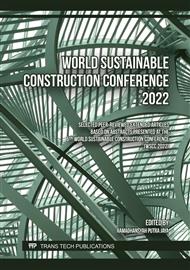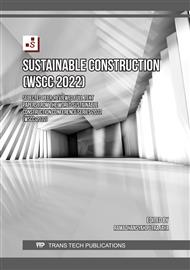[1]
Elsaid, A.; Dawood, M.; Seracino, R.; and Bobko, C. (2011) "Mechanical properties of Kenaf Reinforced Concrete," Construction and Building Materials, 25, pp.1991-2001.
DOI: 10.1016/j.conbuildmat.2010.11.052
Google Scholar
[2]
Mohsin, S. M. S., Manaf, M. F., Sarbini, N. N., & Muthusamy, K. (2016). Behaviour of reinforced concrete beams with kenaf and steel hybrid fibre. ARPN J. of Engineering and Applied Sciences, 11(8), 5385-5390.
Google Scholar
[3]
Baarimah, A. O., & Mohsin, S. S. (2018). Mechanical properties of steel/kenaf (hybrid) fibers added into concrete mixtures. In IOP Conference Series: Materials Science and Engineering (Vol. 342, No. 1, p.012075).
DOI: 10.1088/1757-899x/342/1/012075
Google Scholar
[4]
Sulthan, F., & Saloma. (2019). Influence of Hooked-End Steel Fibers on Fresh and Hardened Properties of Steel Fiber Reinforcement Self-Compacting Concrete (SFRSCC). Journal of Physics: Conf. Series, 1198(2019) 032005.
DOI: 10.1088/1742-6596/1198/3/032005
Google Scholar
[5]
Vinayak, B. S., & N. Gunderao, S.. (2017). Evaluation of the Strength Properties of Hookedn End Steel Fiber Reinforced Concrete Produced with Fly Ash. International Research Journal of Engineering and Technology (IRJET), 04(04), 2275-2278.
Google Scholar
[6]
Brandt, A. M. (2008). Fibre Reinforced Cement-based (FRC) Composites After over 40 Years of Development in Building and Civil Engineering. Composite structures, 86(1-3), 3-9.
DOI: 10.1016/j.compstruct.2008.03.006
Google Scholar
[7]
Mohsin, S. S., Baarimah, A. O., & Jokhio, G. A. (2018). Effect of kenaf fiber in reinforced concrete slab. In IOP Conference Series: Materials Science and Engineering, 342(1), 012104.
DOI: 10.1088/1757-899x/342/1/012104
Google Scholar
[8]
Altun, F., HAktanir, T., & Ari, K. (2007). Effects of Steel Fiber Addition on Mechanical Properties of Concrete and RC Beams. Construction and Building Materials, 21(3), 654-661.
DOI: 10.1016/j.conbuildmat.2005.12.006
Google Scholar
[9]
Ma, K., Qi, T., Liu, H., & Wang, H. (2018). Shear Behaviour of Hybrid Fiber Reinforced Concrete Deep Beams. Materials, 11(10), 2023.
DOI: 10.3390/ma11102023
Google Scholar
[10]
Smarzewski, P. (2019). Analysis of Failure Mechanics in Hybrid Fiber-Reinforced High-Performance Concrete Deep Beams with and Without Openings. Materials, 12(1), 101.
DOI: 10.3390/ma12010101
Google Scholar
[11]
Yao, W., Li, J., & Wu, K. (2003). Mechanical properties of hybrid fiber-reinforced concrete at low fiber volume fraction. Cement and concrete research, 33(1), 27-30.
DOI: 10.1016/s0008-8846(02)00913-4
Google Scholar
[12]
Adole, A. M., Yatim, J. M., Ramli, S. A., Othman, A., & Mizal, N. A. (2019). Kenaf Fiber and its Bio-Based Composites: A Conspectus. Pertanika Journal of Science & Technology, 27(1).
Google Scholar
[13]
Baarimah, A. o., Syed Mohsin, S. M., Alaloul, W. S., & Ba-naimoon, M. S. (2021) Effect of Sodium Hydroxide on Mechanical Characteristics of Kenaf Fiber Reinforced Concrete. Journal of Physics: Conference Series, 1962(2021), 012013.
DOI: 10.1088/1742-6596/1962/1/012013
Google Scholar
[14]
Abbas, A-G. N., Aziz, F. N. A. A., Abdan, K., Nasir, N. A. M., & Norizan, M. N. (2022) Kenaf Fiber Reinforced Cementitious Composites. Fibers, 10(3).
DOI: 10.3390/fib10010003
Google Scholar
[15]
Mohsin, S., Maszura, S., Azimi, S. J., & Namdar, A. (2014). Behaviour of Oil Palm Shell Reinforced Concrete Beams Added with Kenaf Fibres. Applied Mechanics and Materials, 567, 351-355.
DOI: 10.4028/www.scientific.net/amm.567.351
Google Scholar
[16]
Hashim, M. Y., Amin, A. M., Marwah, O. M. F., Othman, M. H., Yunus, M. R. M., & Huat, N. C. (2017). The Effect of Alkali Treatment under Various Conditions on Physical Properties of Kenaf Fiber. Journal of Physics: Conference Series, 914(1), 012030.
DOI: 10.1088/1742-6596/914/1/012030
Google Scholar
[17]
Li, X., Tabil, L.G., & Panigrahi, S. (2007). Chemical Treatments of Natural Fiber for Use in Natural Fiber-Reinforced Composites: A Review. Journal of Polymers and the Environment, 15(1), 25-33.
DOI: 10.1007/s10924-006-0042-3
Google Scholar
[18]
Syed Mohsin S M, Azimi S J, Namdar A. (2014). Behaviour of Oil Palm Shell Reinforced Concrete Beams Added with Kenaf Fibres. Applied Mechanics and Materials, 567, 351-355.
DOI: 10.4028/www.scientific.net/amm.567.351
Google Scholar
[19]
Lam, T. F., & Mohamad-Yatim J. (2015). Mechanical Properties of Kenaf Fiber Reinforced Concrete with Different Fiber Content and Fiber Length. Journal of Asian Concrete Federation, 1 (1), 11-21.
DOI: 10.18702/acf.2015.09.1.11
Google Scholar
[20]
British Standard Institution BS EN 206-1:2000 (2001) Concrete –Specification, Performance, Production and Conformity. London.
Google Scholar
[21]
British Standard 1881: Part-116 (1983) Method for Determination of Compressive Strength of Concrete Cubes, London, British Standard Institution.
Google Scholar
[22]
British Standard 1881: Part-118 (1983) Method for Determination of Flexural Strength. London, British Standard Institution.
Google Scholar
[23]
British Standard 1881: Part-102 (1983) Testing Concrete Method for Determination of Slump, London, British Standard Institution.
Google Scholar



